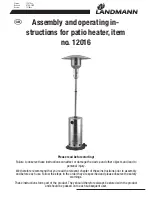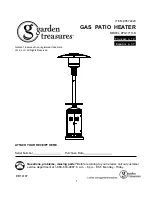
Instructions premix Air heaters type XR10.. 60
Page 12/15
It can also be that the DBC does not send a 230 Volt signal to the coils. In this case, try
another DBC.
b) There are sparks and the gascontrol opens, but the mixture does not ignite. Check if the
flame does ignite if the coloured air inlet ring on the pre-mixfan is closed partially between
thumb and forefinger. There will be less air, so the mixture is richer and ignite easyer. If the
flame now ,becomes established, check the CO2-content when the heater is warm at high
fire. Adjust it if necessary with the adjusting-screw on the gascontrol.
Only
do this with a
good (calibrated) CO2-meter in the outlet of the heater.
The burner ignites briefly, then the heater goes to lock-out
This points to problems with the flame-ionisation. Check first for a sound earth connection in
the heater, by pulling shortly on various earth wires.
The ionisation current itself must be circa 2 microampère. This can be measured, provided
the connections of the multimeter are jumpered during the sparking period in order to prevent
the meter from damage.
Most of the time, problems with the ionisation current, can be solved by replacing the DBC.
Heater does start, but shows other problems.
a) Heater stays on starting speed and does not modulate to a higher work speed : Check if the
pre-mixfan speed does vary if you press the service button of the DFC. Press one time; the
heater will go to low-fire, press one more time; the heater will go to high fire. Pressing a
further time will de-activate the servicemode. After 10 minutes of servicemode this function
will switch off automatically. Check if the heater does function normally if the wires of the
roomthermostat are jumpered (heater must start up and go to full load), and if it switches off
when the wires are opened again. Try first another OpenTherm thermostat. If this does not
work, the DFC must be replaced. It can also be the pre-mixfan itself that does not modulate
inspite of a good input signal. The heat output of the heater will also be insufficient if there is
too much resistance in the inlet- or outlet flue system. In this case the pre-mixfan will be on
full speed, but because of the high resistance too little air is moved and therefore also too
little gas. The pressure in the outlet flue for example, will normally never be above 30 Pascal.
b) Systemfan (M1) does not start or does not vary in speed; Check first the functioning of this
fan by connecting it to 230 Volt. Check with a multimeter if the different lower tensions are
secondary present on the transformator as well. The fuse could have failed. If the motor and
transformer are OK, the cause of the probleem must be in the DFC, as the DFC dictates the
different voltages from the transformer to the fanmotor. In that case, replace the DFC.
c) Delta-T-regulation problems: For this regulation, potentiometer P2 on the DFC is used. This
controls the desired difference in temperature between the room sensor (the OpenTherm)
and the sensor in the heater (NTC). A smaller difference in temperature (potentiometer P2
anti clock wise) will keep the systemfan running on higher speed for longer periods.
Check the functioning of the OpenTherm thermostat by putting it on heathdemand for a
little while. In case this functions well, then check the NTC (measure the Ohm resistance).
The problem may be the DFC. In this case, the DFC must be reprogrammed, or replaced.
Resistance value NTC sensor at 20°C= 25 kOhm.
#
#
5'&# &# '
#
#
5'&# &# '
#
#
5'&# &# '
#
#
5'&# &# '
The heater must be inspected and cleaned regularly (once a year) by a qualified installer who
understands this appliance.
This is all the more important as the circumstances are heavier, especially in case of dust,
humidity, high frequency of switching on/off etc.

































